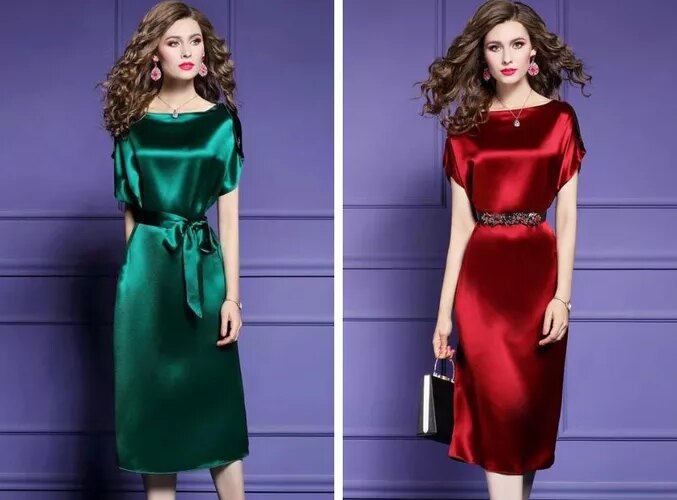Silk fabric is renowned for its luxury and elegance in fashion. Discover its characteristics, pros and cons, and applications. Explore more here.
1. What is silk fabric?
Silk is a luxurious fabric that is produced from the fibers of silk worms. It is renowned for its lustrous appearance, smooth texture, and remarkable softness, making it incredibly pleasant to wear against the skin.
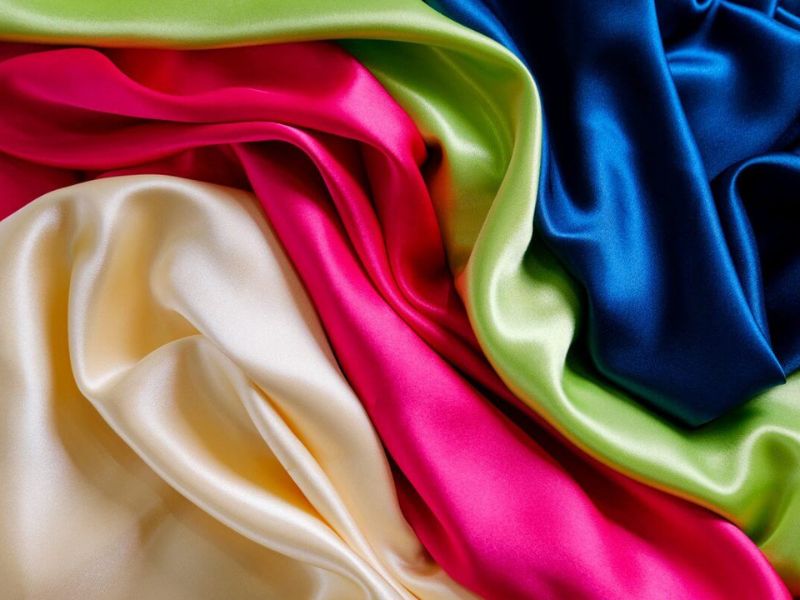
Silk fabric is a luxurious type of fabric that is made from the natural protein fiber produced by certain insects, such as silkworms. The production process of silk involves harvesting the silk thread, which is then woven together to create a smooth, soft, and shiny textile. Silk fabric is highly regarded for its lustrous appearance, delicate texture, and excellent draping qualities. It is known for its breathability and ability to regulate body temperature, making it a popular choice for clothing, bedding, and various other applications. Due to its elegance and high-quality nature, silk fabric is often associated with luxury and is favored by those seeking a refined and comfortable fabric option.
At the same time, silk fabric has the advantage of being less prone to wrinkling and easier to care for compared to other fabrics. This unique characteristic makes silk a preferred choice for making various products in the fashion and interior decoration industry, including dresses, shirts, curtains, and more.
Categorizing silk fabrics into different types.
2.1. Silk
Silk is an opulent fabric that is derived from the silk produced by silkworms, a natural fiber. This luxury material is highly esteemed for its exceptional qualities such as softness, lightness, and smoothness. As a result, silk fabric offers a remarkably comfortable and gentle sensation when it touches the skin.
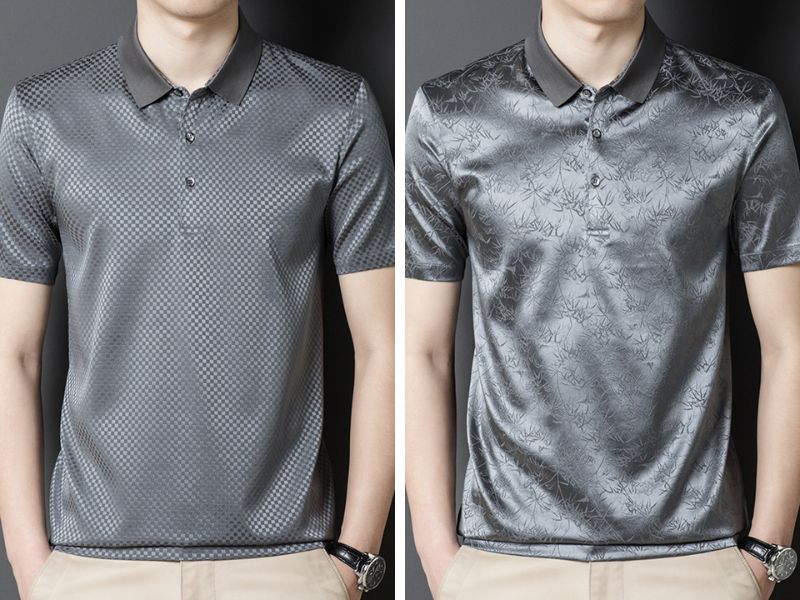
Silk chiffon fabric has a glossy finish and a luxuriously soft texture.
Silk chiffon fabric is crafted from silk fibers, which possess unique qualities of luster, supple texture, and seamless finish. These inherent attributes lend an air of opulence and grandeur when incorporated into garments, furnishings, or decorative items. Not only does silk chiffon fabric exude elegance, but it also boasts excellent sweat-wicking properties and temperature regulation abilities, making it highly sought after for summer attire.
2.2. Satin silk
Satin is a luxurious fabric known for its high-end quality. It is made from a blend of silk, polyester, and other synthetic fibers. What sets it apart is its remarkable softness, glossy appearance, and exceptionally smooth texture. When you run your fingers across satin, you will experience the indulgent and opulent sensation that this fabric exudes.
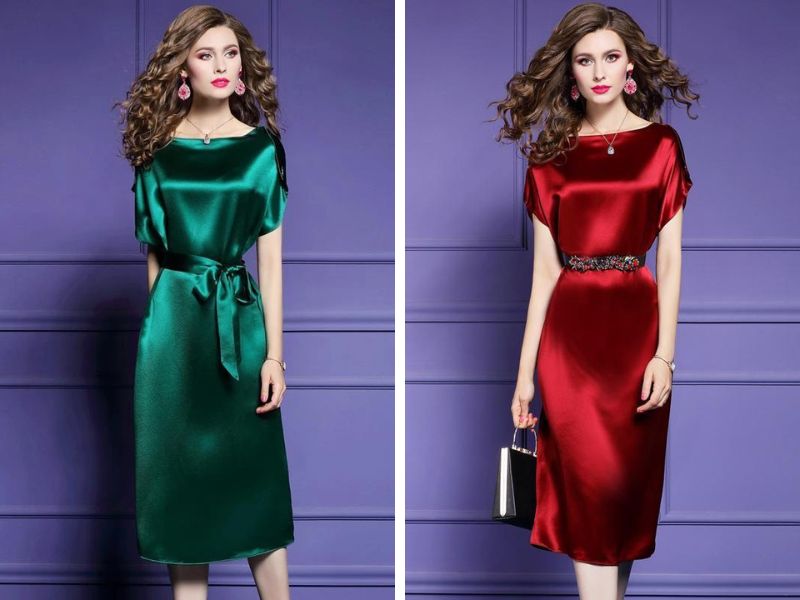
The fabric being described is a luxurious satin chiffon material.
Satin is a highly popular fabric that finds extensive use in the fashion and home decoration industries. Within the fashion realm, satin is particularly favored for creating exquisite evening dresses, wedding gowns, nightgowns, and other upscale garments. The inherent sheen and delightful softness of satin impart a luxurious and aristocratic appearance to any article of clothing made from it.
2.3. Silk brocade
Silk brocade is an opulent fabric that stands out due to its unique texture and shine. It is crafted from a blend of natural fibers like silk and synthetic fibers like polyester. The defining characteristic of this fabric is its stunning brocade surface, which provides a rich, structured appearance and catches the light in a captivating manner.
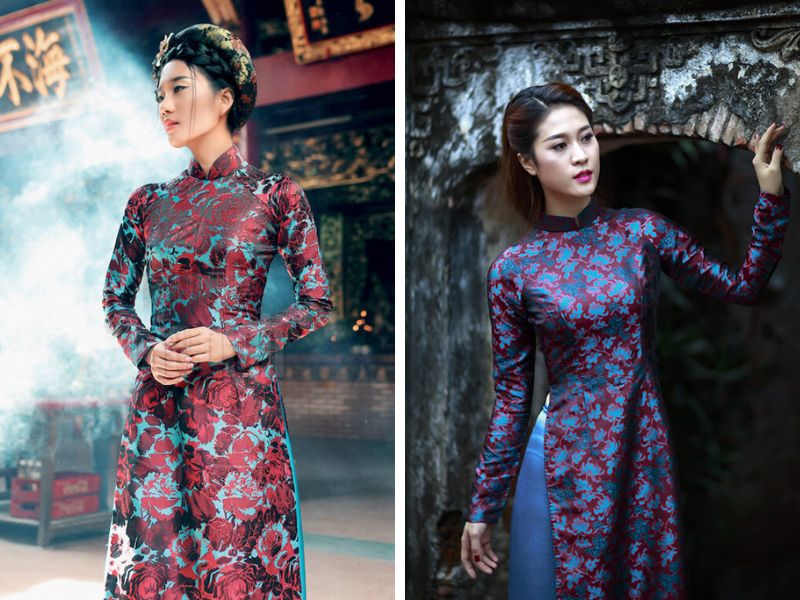
Luxurious and exclusive, the silk brocade fabric stands out with its intricately woven patterns and sumptuous texture. It showcases a captivating blend of colors, featuring an array of vibrant hues that catch the eye and add a touch of elegance to any garment or home decor item. The intricate design work on the fabric is carefully crafted, revealing an exquisite attention to detail that sets it apart from ordinary materials. With its smooth, silky feel and unparalleled visual appeal, this silk brocade fabric is a true testament to luxury and sophistication.
Silk brocade fabric is highly favored for crafting exquisite and elegant costumes, including evening dresses, wedding gowns, and performance attire. Its allure lies in the enchanting and opulent aesthetics it imparts.
2.4. Twill silk
Twill silk fabric is a unique type of textile that is produced using the twill weaving technique. This weaving technique results in a fabric structure with diagonal seams positioned at a 45-degree angle. As a result, twill silk fabric has a smooth and soft surface, enhancing its overall texture. Moreover, this fabric also possesses a certain level of durability and elasticity, making it a desirable choice for various applications.
Twill silk fabric is typically made using natural silk fibers along with other synthetic materials. This fabric is crafted using a twill weave structure, resulting in a glossy and elegant sheen that is synonymous with silk. Its luxurious and sophisticated texture adds a touch of class to any garment or item made from this fabric.
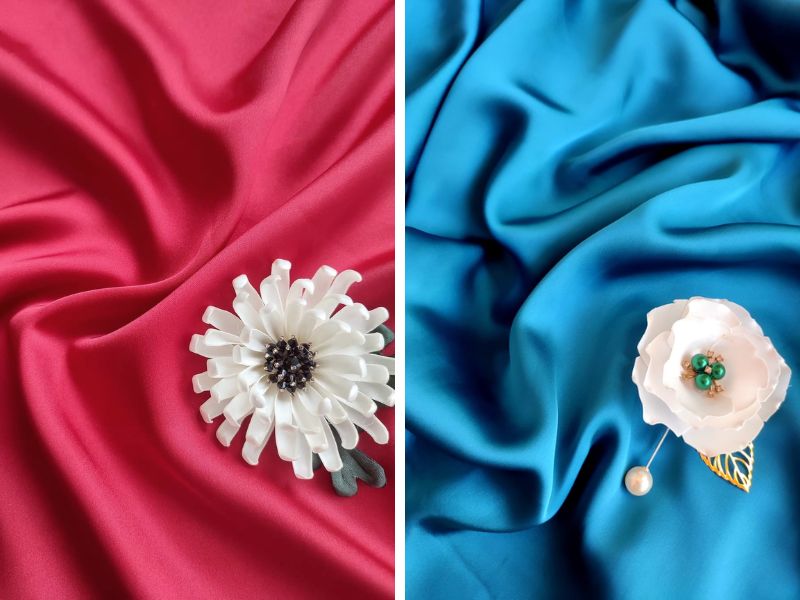
Twill silk fabric is renowned for its exquisite sheen, lightweight texture, and elegant appearance. It exudes a sense of sophistication and refinement, making it a popular choice for high-end clothing and luxurious accessories. With its lustrous surface, twill silk fabric adds a touch of opulence to any outfit or décor. The combination of its smooth feel and delicate drape further enhances its allure, creating a versatile fabric that is both visually captivating and comfortable to wear.
Twill silk fabric has a unique structure that makes it both soft and durable, making it highly versatile for various applications. It is commonly used in the creation of high-end clothing items like vests, blazers, pants, and dresses, as it offers a perfect blend of aesthetic appeal and functionality.
2.5. Cotton silk
Cotton chiffon fabric is a special type of fabric that is made by blending silk and cotton fibers. It is known for its soft and breathable texture, owing to the presence of natural cotton fibers. The most notable characteristic of this fabric is its unique chiffon woven structure, which gives it a smooth and glossy surface with a subtle shine.
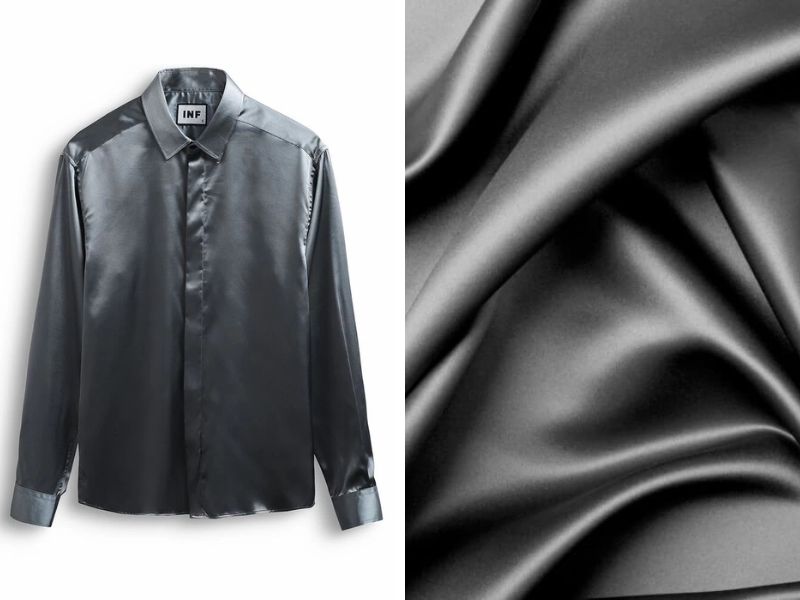
Cotton silk fabric has a high absorbency rate, allowing it to efficiently soak up liquids and moisture.
Cotton chiffon fabric is made by blending natural cotton fibers with a woven chiffon structure. The resulting fabric offers a unique combination of the softness and absorbency of cotton, along with the attractive and smooth texture of chiffon. This blend creates a comfortable and delightful sensation when it touches the skin, while also exuding an air of elegance and luxury.
Cotton chiffon fabric, known for its softness and breathability, is commonly utilized in the creation of various clothing items such as shirts, T-shirts, skirts, and pants. This fabric is particularly popular during the summer season due to its ability to provide the wearer with coolness and comfort.
Pros and cons of silk fabric.
3.1. Advantages of silk fabric
- Soft and smooth: Silk fabric has a smooth, shiny surface and a slight drape, creating a soft and luxurious feel when worn.
- Cool: Silk fabric has good sweat absorption, helping the wearer feel comfortable and cool.
- Light and airy: Chiffon fabric is lightweight, creating a feeling of lightness when worn.
- Luxurious and elegant: Silk fabric has a smooth, shiny surface, creating a luxurious and noble look for the wearer.
- Easy to wash: Silk fabric can be hand washed or machine washed on gentle cycle.
- Durable: Silk fabric is durable and can be used for a long time if well maintained.
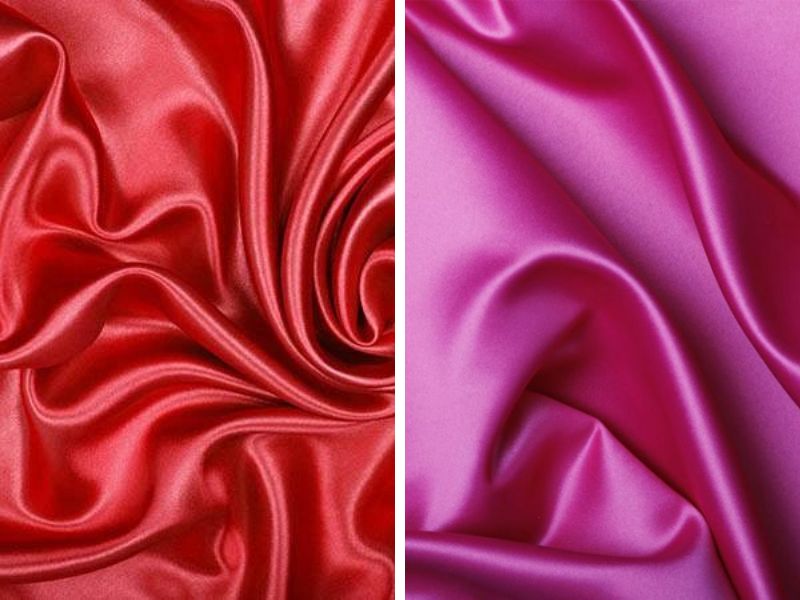
Silk fabric offers various advantages and disadvantages.
One of the advantages of silk fabric is its luxurious and elegant appearance. The smooth and shiny texture of silk gives a sophisticated and high-end feel to clothing and home furnishings.
Additionally, silk fabric is known for its exceptional comfort. It is lightweight, breathable, and has excellent draping qualities, making it a popular choice for summer clothing and bedding.
Silk also has natural temperature-regulating properties. It can help keep the body cool in hot weather and provide insulation during colder seasons.
Moreover, silk fabric is hypoallergenic and less likely to cause skin irritation compared to other fabrics. It is an excellent option for individuals with sensitive skin or allergies.
However, silk fabric also has its disadvantages. One of the main drawbacks is its high cost. The intricate and time-consuming production process makes silk fabrics expensive compared to synthetic alternatives.
Silk is also more delicate and requires special care when washing and handling. It is prone to wrinkles, and certain types of silk may be prone to shrinking or color fading if not handled properly.
Additionally, silk fabric is not as durable as other materials. It may wear out more quickly, especially in high-friction areas or with regular heavy use.
Furthermore, silk is susceptible to damage from sunlight and moisture. Prolonged exposure to sunlight can cause the fabric to fade or weaken, and excessive moisture can lead to mold or mildew growth.
In conclusion, while silk fabric offers many desirable qualities such as its luxurious appearance, comfort, and hypoallergenic nature, it is important to consider its cost, delicate nature, and susceptibility to damage before choosing it for a particular purpose.
Drawbacks of silk fabric include its high cost, delicate nature, and susceptibility to damage from moisture and heat.
- High price: Silk fabric, especially silk chiffon, is quite expensive compared to regular fabrics.
- Wrinkle easily: Silk fabric wrinkles easily and needs to be ironed regularly to keep its shape.
- Easy to collect dust: Silk fabric has a smooth surface so it easily attracts dirt.
- Sensitive to sunlight: Silk fabric may fade if exposed to direct sunlight.
Advice on selecting and maintaining silk fabric.
Here are several practical tips to assist you in selecting and maintaining silk fabric with efficiency and effectiveness:
1. Educate yourself about different types of silk: Familiarize yourself with the various types of silk available in the market, such as mulberry silk, tussar silk, and chiffon silk. Understanding the characteristics of each type will aid in making an informed choice.
2. Consider the purpose: Determine the purpose for which you are purchasing silk fabric. Whether it’s for clothing, home décor, or accessories, knowing the specific use will help you select the appropriate weight and texture of silk.
3. Check fabric quality: Inspect the silk fabric closely to ensure it is of good quality. Look for consistent color, strong and even threads, and minimal flaws or imperfections.
4. Test for colorfastness: If you plan to wash or clean the silk fabric, perform a colorfastness test in a small, inconspicuous area. Dampen a cotton cloth in a mild detergent solution and gently rub it on the fabric. If any color transfers, the fabric may not be colorfast.
5. Follow care instructions: Always follow the care instructions provided by the manufacturer or retailer. Silk fabric may require dry cleaning or handwashing with mild detergent. Avoid using harsh chemicals, bleach, or wringing the fabric, as they can damage the fibers.
6. Store silk fabric properly: To preserve silk fabric, store it in a cool, dry place away from direct sunlight. Avoid hanging silk garments on wire hangers as they may cause distortion. Instead, use padded hangers or lay silk fabric flat in a drawer.
7. Handle with care: Be gentle while handling silk fabric, as it is delicate and can tear easily. Avoid contact with sharp objects or rough surfaces that could snag or pull the fabric.
8. Test for heat tolerance: Before ironing silk fabric, test a small portion using a low heat setting on the iron. If the fabric can withstand the heat, proceed with gentle ironing using a pressing cloth to protect the silk fibers.
By following these detailed tips, you will be able to choose silk fabric wisely and preserve its beauty and quality for an extended period.
Deciding to purchase silk fabric.
- Material testing: Choose silk fabrics from reputable manufacturers and make sure that the material used is high quality natural silk or synthetic fibers.
- Consider the fabric structure: Check the fabric structure to ensure there are no loose threads or tangled silk threads, ensuring product quality.
- Choose the right color and pattern: Choose a color and pattern that suits your needs and style, remember that chiffon fabric often has a light sheen so choose a color that you like but is not too bright.
- Fabric feel test: Feel the surface and softness of the fabric by touching it lightly, choose soft and breathable fabric to bring comfortable feeling when using.
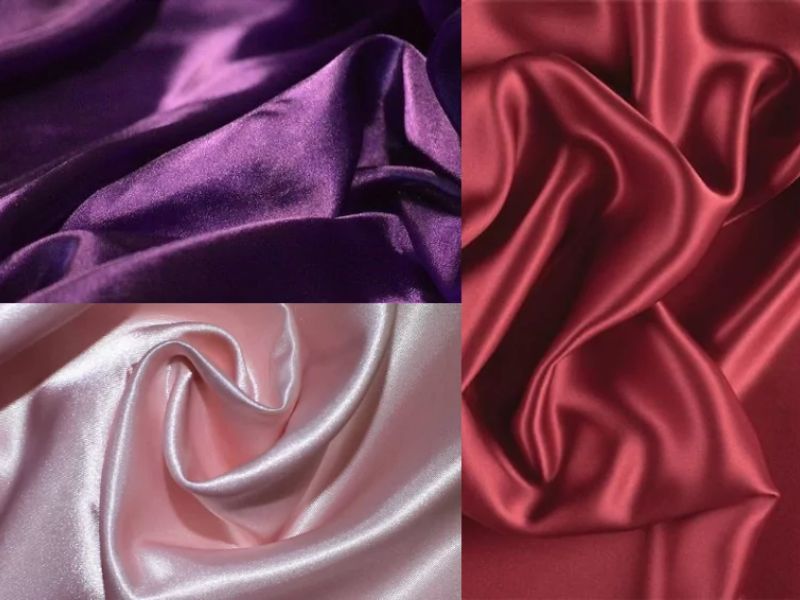
Below is a detailed guide on how to properly select and maintain silk fabric:
1. Choosing Silk Fabric:
– Consider the purpose: Determine the type of silk fabric based on its intended use, such as clothing, household items, or accessories.
– Check the weight: Silk comes in various weights, including lightweight, medium-weight, and heavy-weight. Select the appropriate weight according to your project requirements.
– Evaluate the quality: Look for high-quality silk that has a smooth texture, even color, and minimal flaws. Check for any signs of snags or pulled threads.
– Consider the dye: If you prefer a specific color or pattern, ensure that the dye used on the silk is colorfast and will not bleed or fade when washed.
2. Caring for Silk Fabric:
– Dry cleaning: Opt for professional dry cleaning for delicate or heavily embellished silk fabrics to avoid damaging the fibers.
– Handwashing: For less delicate silk fabrics, it is best to hand wash them using a mild detergent specifically designed for silk. Gently agitate the fabric in lukewarm water, rinse thoroughly, and lay flat to air dry.
– Ironing: Set the iron to a low heat or silk setting and use a pressing cloth or a clean towel to prevent direct contact between the iron and the silk fabric. Iron the fabric on the reverse side to avoid leaving any shine marks or scorching.
– Storing silk: Store silk fabric in a cool, dry place away from direct sunlight to prevent fading and discoloration. Use acid-free tissue paper to wrap silk garments or fold them carefully and place them in a breathable garment bag.
– Avoiding moisture and chemicals: Keep silk fabrics away from moisture, such as damp areas or high humidity, as they can cause mold or mildew. Additionally, avoid exposing silk to harsh chemicals, including perfumes or hair sprays, as they can damage the fabric.
By following these detailed instructions, you can choose the right silk fabric and ensure its long-lasting beauty and durability.
Maintaining the integrity of silk fabric
- Proper storage: Store silk fabric in a cool, dry place, away from direct sunlight and high humidity.
- Avoid folding corners: Avoid folding the corners of silk fabric when storing to avoid creating unwanted wrinkles.
- Hand wash or machine wash gentle cycle: When washing, use cold water and a gentle cycle to avoid damaging the fabric’s structure and color.
- Avoid using harsh chemicals: Avoid using harsh detergents or bleaches to preserve silk fabrics, as they may damage the quality and color of the fabric.
- Dry gently: Dry silk fabrics by hanging or airing in a cool space, avoid using a dryer and avoid drying by rubbing too vigorously.
Conclude
Chiffon fabric, with its set of advantages and disadvantages, remains the preferred choice for individuals seeking to incorporate a touch of luxury and sophistication into their fashion choices. Whether it’s for glamorous evening gowns or everyday attire, chiffon fabric effortlessly exudes an air of class and elegance, making it an emblematic choice for those who value refined style.
Fashion Bandung is a fashion brand that specializes in clothing for men. Our collection offers a wide range of stylish and trendy clothing options for men of all ages. We pride ourselves on providing high-quality garments that not only enhance the wearer’s style but also offer comfort and durability. Our team of designers and fashion experts work diligently to stay ahead of the latest fashion trends, ensuring that our customers are always on the cutting edge of style. Whether you’re looking for casual wear, formal attire, or accessories to complete your look, Fashion Bandung has you covered. We are committed to providing exceptional customer service and strive to create a personalized shopping experience for each individual. Choose Fashion Bandung for all your fashion needs and elevate your style with our premium men’s clothing collection.
To access additional content, please click on the “See more” button.

